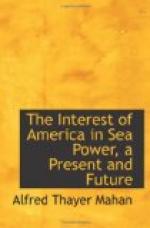overshadowed by the larger island, which it so conspicuously
confronts. If, as has just been said, it by situation
intercepts the access of Cuba to the Isthmus, it is
itself cut off by its huge neighbor from secure communication
with the North American Continent, now as always the
chief natural source of supplies for the West Indies,
which do not produce the great staples of life.
With the United States friendly or neutral, in a case
of war, there can be no comparison between the advantages
of Cuba, conferred by its situation and its size, and
those of Jamaica, which, by these qualities of its
rival, is effectually cut off from that source of
supplies. Nor is the disadvantage of Jamaica
less marked with reference to communication with other
quarters than the United States—with Halifax,
with Bermuda, with Europe. Its distance from
these points, and from Santa Lucia, where the resources
of Europe may be said to focus for it, makes its situation
one of extreme isolation; a condition emphasized by
the fact that both Bermuda and Santa Lucia are themselves
dependent upon outside sources for anything they may
send to Jamaica. At all these points, coal, the
great factor of modern naval war, must be stored and
the supply maintained. They do not produce it.
The mere size of Cuba, the amount of population which
it has, or ought to have, the number of its seaports,
the extent of the industries possible to it, tend naturally
to an accumulation of resources such as great mercantile
communities always entail. These, combined with
its nearness to the United States, and its other advantages
of situation, make Cuba a position that can have no
military rival among the islands of the world, except
Ireland. With a friendly United States, isolation
is impossible to Cuba.
The aim of any discussion such as this should be to
narrow down, by a gradual elimination, the various
factors to be considered, in order that the decisive
ones, remaining, may become conspicuously visible.
The trees being thus thinned out, the features of the
strategic landscape can appear. The primary processes
in the present case have been carried out before seeking
the attention of the reader, to whom the first approximations
have been presented under three heads. First,
the two decisive centres, the mouth of the Mississippi
and the Isthmus. Second, the four principal routes,
connecting these two points with others, have been
specified; these routes being, 1, between the Isthmus
and the Mississippi themselves; 2, from the Isthmus
to the North American coast, by the Windward Passage;
3, from the Gulf of Mexico to the North American coast,
by the Strait of Florida; and, 4, from the Isthmus
to Europe, by the Anegada Passage. Third, the
principal military positions throughout the region
in question have been laid down, and their individual
and relative importance indicated.




